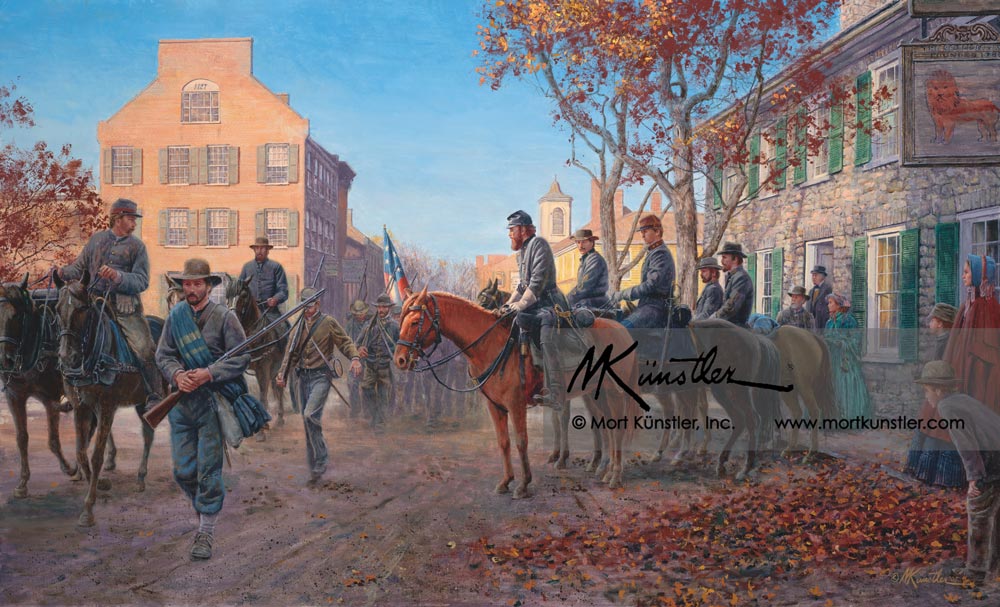Künstler
Lion of the Valley
Lion of the Valley
Couldn't load pickup availability
This is Mort Künstler limited edition print - Lion of the Valley. Jackson in Winchester, Va. November 6, 1861.
LIMITED EDITION PRINTS
Paper Prints
Reproduction technique: Fine offset lithography on neutral pH archival quality paper using the finest fade-resistant inks.
Each print is numbered and signed by the artist and accompanied by a Certificate of Authenticity.
Image Size: 17” x 28” • Overall Size: 22” x 32”
Signed & Numbered • Edition Size: 500
Signed Artist’s Proof • Edition Size: 50
Giclée Canvas Prints
Reproduction technique: Giclées are printed with the finest archival pigmented inks on canvas.
Each print is numbered and signed by the artist and accompanied by a Certificate of Authenticity.
Size: 20” x 33”
Signed & Numbered • Edition Size: 100
Signed Artist’s Proof • Edition Size: 10
Historical Information
No longer was he “Tom Fool” Jackson. That’s what some cadets had called Major Thomas J. Jackson a year earlier at the Virginia Military Institute, where he had lectured on artillery principles, astronomy and physics. He was an expert at artillery, and he memorized his other subjects, but his classroom presentation was anything but inspiring. One student called him “the worst teacher God ever made.” His demanding discipline resulted in the expulsion of six cadets, and prompted one student to challenge him to a duel. He often appeared lost in his thoughts, and sometimes even forgot to eat. He walked with an awkward gait, laughed in a peculiar and soundless manner, and would abruptly raise his arm and make a pumping motion to stimulate blood circulation. Beneath such eccentric behavior, however, lay one of history’s brightest military geniuses.
By the time he established his headquarters in Winchester, Virginia in 1861, Jackson’s odd habits were overshadowed by his celebrated fame. “Tom Fool” Jackson had become “Stonewall” Jackson – the hero of the Confederate victory at First Manassas. A graduate of West Point and a Mexican War veteran, Jackson had left VMI for Confederate service, demonstrating a command ability that quickly spurred him to the rank of brigadier general and command of a brigade of Virginia troops from the Shenandoah Valley. His rock-hard defense of Henry House Hill at the battle of First Manassas earned him the nickname “Stonewall” Jackson, and made his name heroically famous throughout the South. In November of 1861, he was promoted to major general and placed in command of defending the Shenandoah Valley with headquarters at Winchester. When Jackson led his troops into town on November 6, the residents of Winchester realized they had a legend in their midst – but the flame of fame would soon burn with even greater brilliance.
In the spring of 1862, Jackson would unleash his remarkable “Valley Campaign” and demonstrate his exceptional military genius. In an extraordinary display of hard marching, hard fighting and brilliant maneuvering, Jackson and his “foot cavalry” would humiliate the Northern armies that threatened the Shenandoah Valley. His triumph there would make him the lion of the Valley, and produce a year-long partnership with General Robert E. Lee that would make Stonewall Jackson one of history’s leading military legends.
Mort Künstler’s Comments
Winchester is one of my favorite places in Virginia. It was also one of Stonewall Jackson’s favorites, and he spent four of the happiest months of his life there. I’ve painted many pictures of Winchester and the surrounding area, but none that I like more than this one. Lion of the Valley depicts General Jackson and his brigade entering Winchester the day he established his headquarters there in 1862. In it, you’ll see two period structures that were familiar to everyone in Winchester during the Civil War – the 1827 House and the Red Lion Tavern, which was established in 1783. Both still look much the same today, and I believe they have never been depicted with Jackson in a painting. They’re wonderful examples of 19th century southern architecture and I think they add a very compelling element to the painting. I’m so glad I learned about this scene and the appearance of these Civil War structures.
Jackson’s arrival at his new headquarters in early November gave me the opportunity to use the seasonal colors of the leaves which, combined with the clear blue sky and bright sunlight, impart the optimism that was felt by Jackson and the army at this time of the war. I deliberately placed only Stonewall and Little Sorrel in sunlight to make them the center of attention. To reinforce this design element, I painted Jackson as the only figure clearly silhouetted against the sky. I utilized one point perspective to additionally draw the eye to the general by having the lines of the buildings, the curbing, and the wagon tracks lead the viewer to Jackson. The Loudon Street Presbyterian Church is aptly positioned directly behind Jackson. He worshipped there and passed by countless times in the exercise of his duties.
The first national flag catches the sunlight and adds an additional touch of color to the painting. The mounted artilleryman on the extreme left looks at Jackson as he goes by; that and the direction of the infantry soldier's rifle lead the viewers attention always back to the painting's centerpiece: Stonewall Jackson. That's the intent of the painting - the focus on Jackson. He would soon lead his amazing “Valley Campaign,” which would catapult him into even greater fame. I believe this painting clearly suggests the strength of character and command that would make Stonewall Jackson the lion of the Shenandoah Valley.
Share


Continue Shopping
See more of the Breagans' collection of manufacturers from all around the world
Subscribe to our emails
Subscribe to our mailing list for insider news, product launches, and more.

